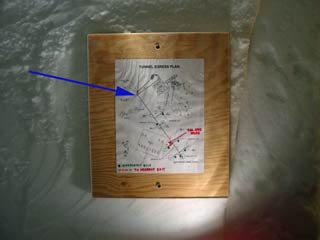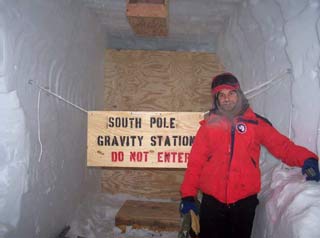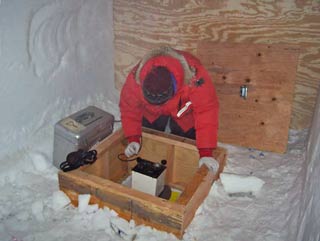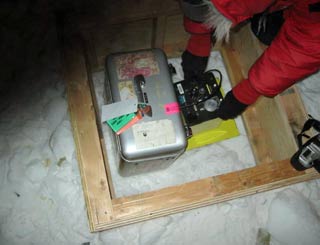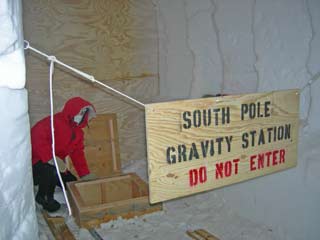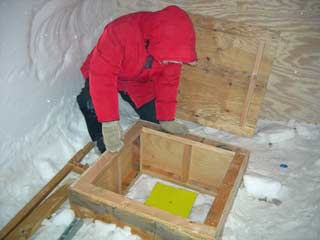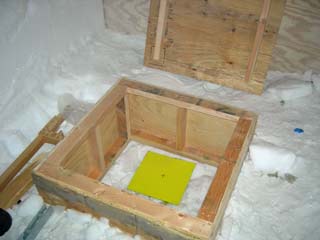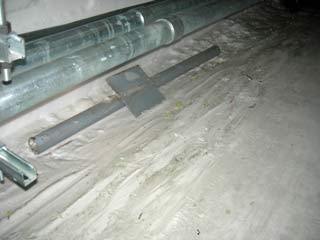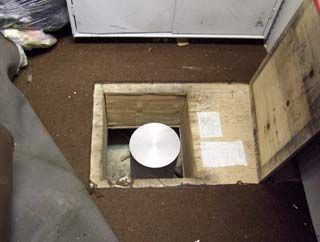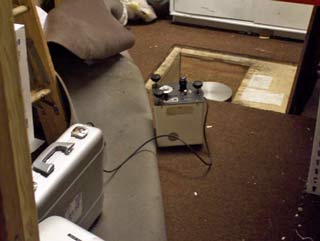More than you ever thought you wanted to know about the gravity vault
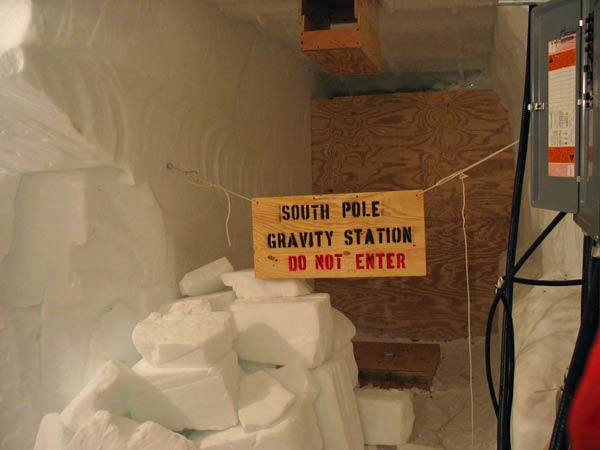
The newly completed gravity vault in January 2004 (SW).
|
Everyone who has been in the ice tunnels since January 2004 has walked past this gravity station, and I'm sure that almost everyone who has walked past it wondered what was actually going on here. After all, there are no power or data cables...merely that forbidding sign. So...during my 2008 winter I decided to demystify things a bit. I got with science tech Lance Roth who was involved with monitoring the SPRESSO seismic vault among other projects, and we obtained official permission to enter and investigate. | ||
| If you haven't been in the ice tunnels, the blue arrow in the image at left indicates the vault location. This 90º corner in the tunnels originally had access tunnels to the surface to allow access by the tunneling machine. The vault was located in the end of one of the filled-in access tunnels. I've used this 2004 escape route map as it is less faded than they are nowadays (SW). | ||
|
Above...the secret is fully revealed. The vault contains...a steel plate. Nothing else. But what is really going on?? This is not a monitoring station, but rather an internationally documented location for scientists to place their gravimeters to take gravity readings. A gravimeter is, basically, an instrument to measure the force of gravity. What's that? Well, ignoring Einstein's relativity stuff, it basically is the constant g which refers to the rate of acceleration of falling objects. Generally this is is 9.8 meters/second squared or 32.2 feet/second squared...but the actual value varies significantly depending on the altitude and the amount of distance/ice/solid rock/molten rock between you and the center of the Earth. And it may not be constant at a given location...when I wintered in 1977 there was a UCLA science project underway called "earth tides" which attempted to measure changes in gravitational force. This occupied a small building behind the science building which more recently in the 2000's before dome demo was used as the facility engineering and survey office.
A gravimeter is essentially an extremely accurate spring scale which is attached to a known mass. There are two types--a "relative" gravity meter which can measure changes in gravity between two locations, and and absolute meter which is much more accurate and expensive. | ||
|
One of the first investigations to use this new gravity measuring station was the Chilean scientific traverse that traveled from Patriot Hills to Pole in 2004-05. At left, here's what the pier was made of--one of the spare pipe supports (like this one) which were embedded in the side walls of the ice tunnels to support the water/sewer lines, conduit etc. The plate was cut off of the side of the pipe and welded to the top. |
||
|
I'll finish up with a couple of photos of the domed station gravity pier (TD)...Now I'm not sure where it was...I thought I unscrewed the floor hatch and saw it in the science building...but perhaps it was in that former UCLA gravity vault behind the science building. Theresa Diehl took readings in both the dome and ice tunnel gravity stations on 19 November 2004...her results were 5961.48 mGal in the dome station and 5963.12 mGal in the new ice tunnel station. What's a mGal? Well, gal is named after Galileo, that guy who became famous after supposedly dropping balls from the Leaning Tower of Pisa. The unit is not an official part of the metric (SI) system, but a gal represents an acceleration of 1 centimeter (or 0.01 m)/second squared...so a mGal is 1/1000 of that. | ||
|
Credits and references...many of the photos are mine...a couple are by Seth White (SW), and Paul Sullivan (PS) helped me with some information and was also involved in the photos. But by far the most helpful information was this 2005 technical report Field Guide to Antarctic Gravity Stations Visited During the 2004-2005 AGASEA Airborne Campaign by Theresa Diehl (TD) (University of Texas). It is the source of most of the technical information. And I cannot end this page without mentioning another much earlier gravity vault...the one at Old Pole...which was visited in February 1961 by Sir Charles Wright, the physicist on Scott's tragic 1910-13 Terra Nova expedition. | ||
